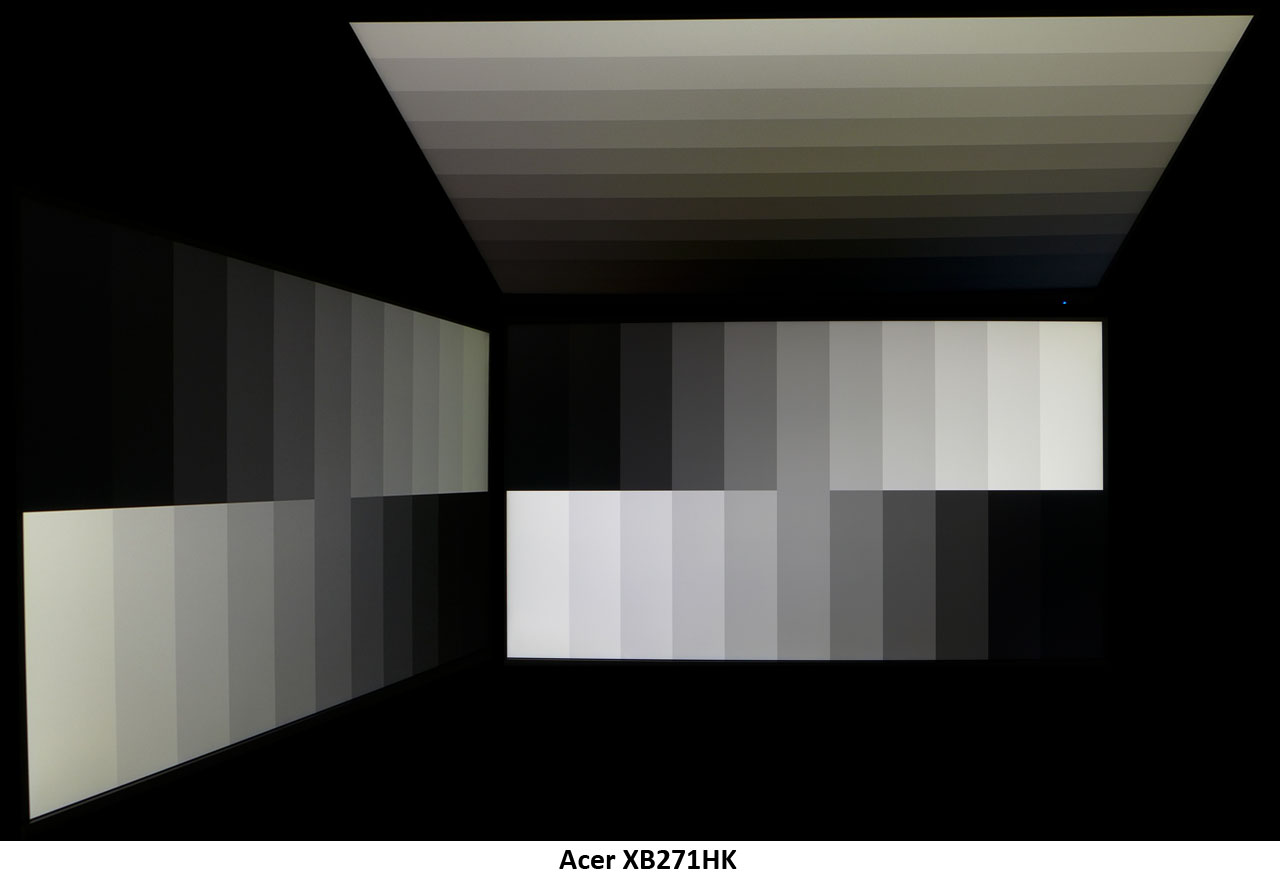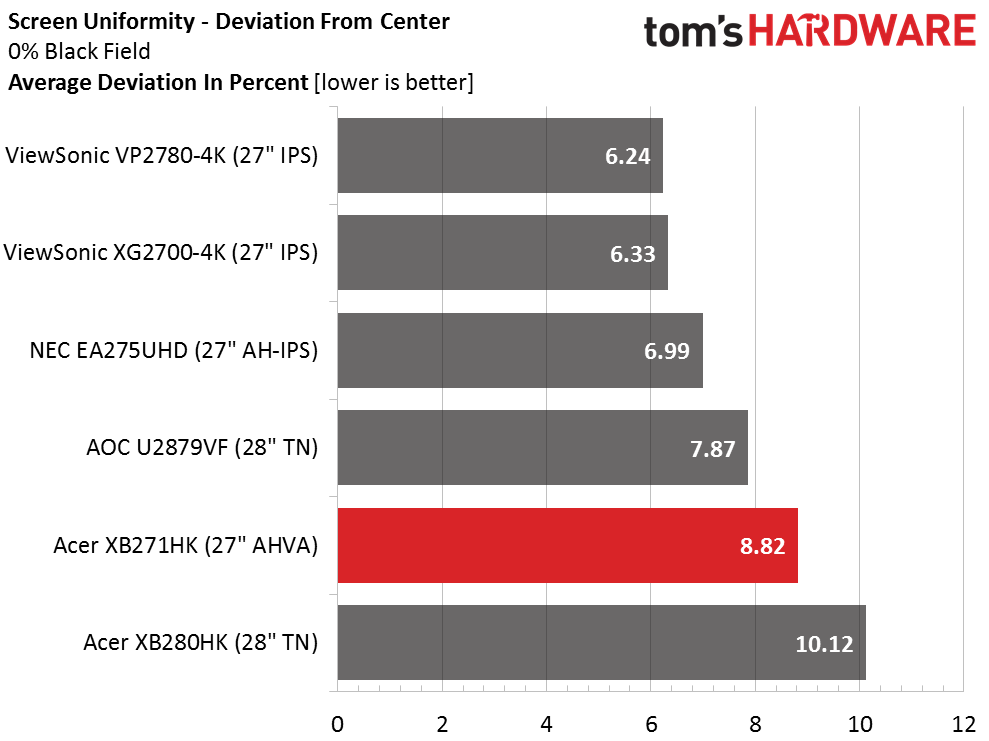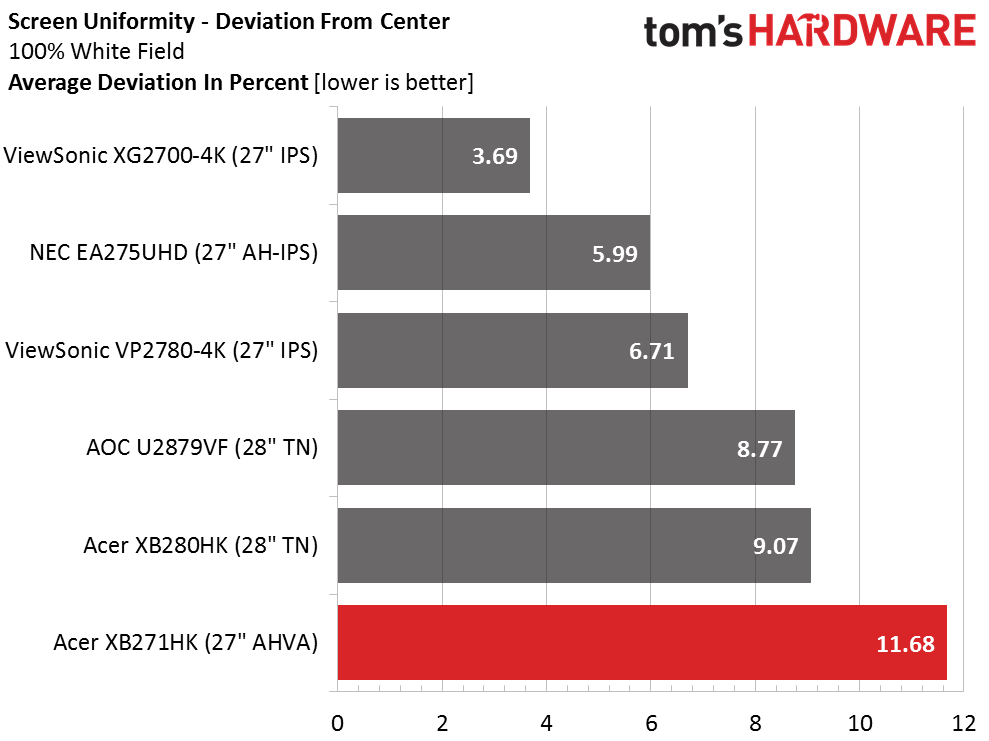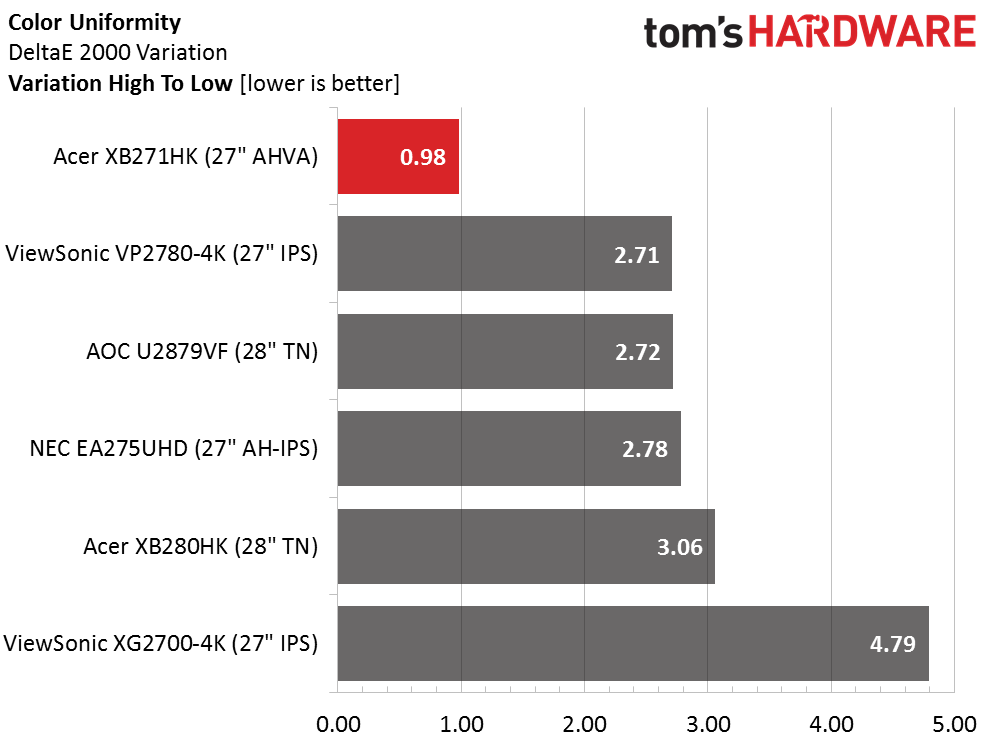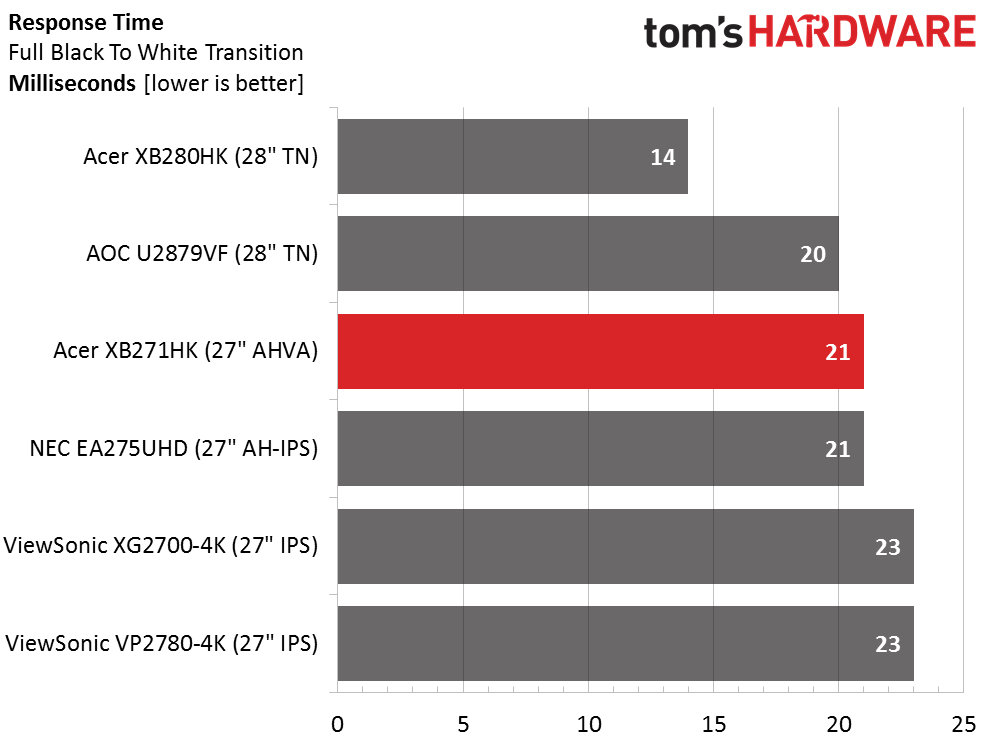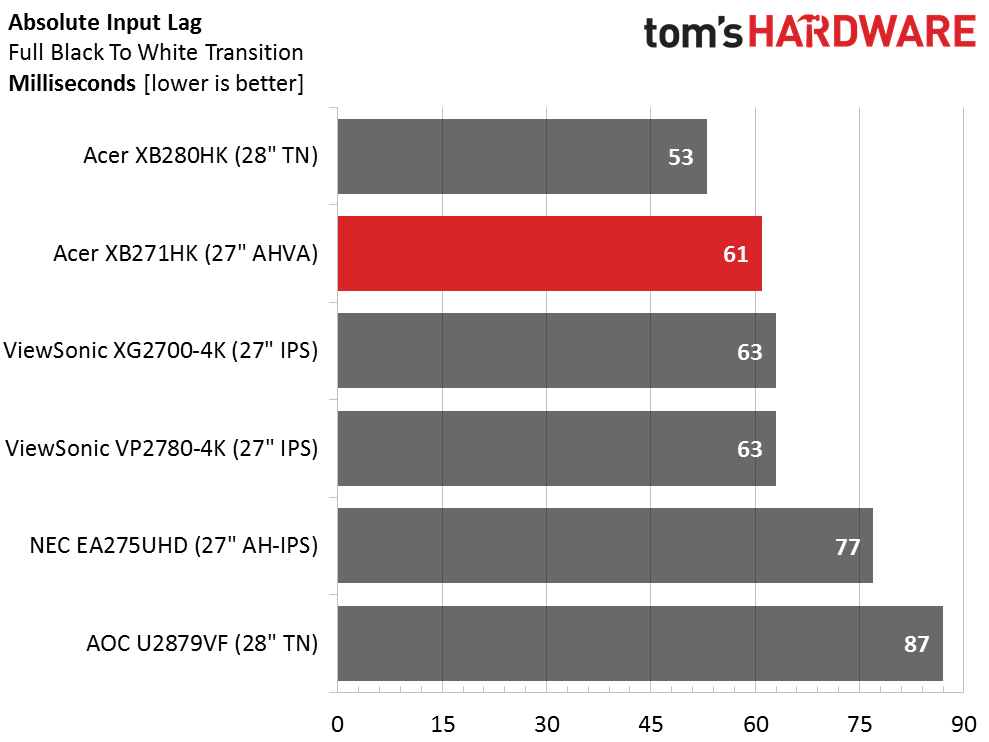Acer Predator XB271HK 27-inch UHD G-Sync Monitor Review
Gamers seeking Ultra HD resolution have few choices but an excellent new G-Sync monitor has just appeared from Acer, the XB271HK sporting a 27-inch AHVA screen. We’re checking it out in our lab today.
Why you can trust Tom's Hardware
Viewing Angles, Uniformity, Response And Lag, G-Sync
To learn how we measure screen uniformity, please click here.
Acer lists the XB271HK as an IPS-type panel but it’s plain from our photos that it’s of the AHVA variety. This technology prioritizes viewing angles by reducing the thickness of the grid polarizer. The result is only a slight output reduction when seen from 45 degrees to the sides or above. The color shift is a touch green but nowhere near as much as a typical IPS panel. Detail retention in the vertical plane is also exceptional when compared to any other LCD display variant.
Screen Uniformity: Luminance
Our sample measures well in the black field test. All the zones are within a hair of each other except the bottom right. You’ll recall that zone also skewed the ANSI test a bit. If not for that, this result would likely have been a top-finisher. Even so, we still have no visual problems to report. IPS glow or light bleed are not in evidence here.
Here’s the white field measurement.
In the white field test we can see a slight center hotspot, and the bottom third of the screen measures a little higher than the upper six zones. It’s just barely visible in the test pattern but doesn’t seem to affect any of the content we viewed during gameplay or productivity testing.
Screen Uniformity: Color
Color uniformity is among the best we’ve seen from the 80-plus panels we’ve tested since 2013. The only panel in this group that actually has a visual issue is the XG2700-4K. The rest are within our preferred tolerance levels. This metric varies from sample to sample, but we rarely see a display with serious issues in this test.
Pixel Response And Input Lag
Please click here to read up on our pixel response and input lag testing procedures.
Get Tom's Hardware's best news and in-depth reviews, straight to your inbox.
Only the XB280HK seems to be able to break the 20ms barrier for 60Hz screens. The AOC, also a TN panel, is next fastest. While you might see a 6ms difference in motion blur, it’s unlikely anyone would see a one or two millisecond variation. Combined with G-Sync, we have no complaints about the motion processing of the XB271HK.
Here are the lag results.
Acer leads the pack in input lag with both its Ultra HD displays. The TN panel seems to have the edge, which isn’t surprising given its 8-bit color depth. That the XB271HK can manage a 61ms result with a native 10-bit rendering is impressive. When it comes to gaming at such high resolutions, input lag is only one of many concerns. An underpowered video card will introduce judder and other artifacts that also serve to harm the gaming experience.
Gaming With G-Sync
As long as one stays within the adaptive refresh range of a particular monitor, there is no visual difference between G-Sync and FreeSync in a gameplay situation. However when dealing with Ultra HD resolution and its 60Hz rate cap, the bottom of the range becomes important because the operational window is smaller. We’ve reviewed a couple of FreeSync screens that came with an uncomfortably high lower limit and made setting game detail levels difficult. With a G-sync screen though, you’ll never get tearing below the minimum refresh rate because frame doubling takes over. For example, if the bottom is 30Hz and the frame rate drops to 29, the screen starts refreshing at 58Hz and drawing each frame twice. So all you see is a gradual increase in judder until the game becomes unplayable due to excessive input lag.
Another thing we’re trying to decide is just how much Ultra HD resolution improves the gaming experience. With a QHD display, framerates can be pushed beyond 60Hz which makes the whole thing much smoother. When you consider that the biggest disadvantage of any LCD panel is its inherent motion blur, it makes sense that faster refresh is the way to smooth motion. Playing at a maximum of 60Hz is fine but not exceptional when it comes to fast on-screen movement. And after testing many gaming monitors, it looks to us like 75Hz is a pretty good threshold to shoot for. At that speed, motion blur is virtually non-existent, even without the use of overdrive or backlight strobing.
In the XB271HK’s case, we performed our usual torture tests playing Tomb Raider, Far Cry 4 and Battlefield 4. Perceptions were pretty much the same as we’d seen on previous Ultra HD panels with adaptive refresh. Tear-free rendering – check. Reduce motion blur with overdrive – check. Judder when framerates drop below 40 – check. Acer’s overdrive implementation is fairly conservative which means there’s no ghosting but not a significant blur reduction either. We settled on Normal as the best setting. And G-Sync’s frame doubling ensured that the experience didn’t change when things got slow.
Current page: Viewing Angles, Uniformity, Response And Lag, G-Sync
Prev Page Color Gamut And Performance Next Page Conclusion
Christian Eberle is a Contributing Editor for Tom's Hardware US. He's a veteran reviewer of A/V equipment, specializing in monitors. Christian began his obsession with tech when he built his first PC in 1991, a 286 running DOS 3.0 at a blazing 12MHz. In 2006, he undertook training from the Imaging Science Foundation in video calibration and testing and thus started a passion for precise imaging that persists to this day. He is also a professional musician with a degree from the New England Conservatory as a classical bassoonist which he used to good effect as a performer with the West Point Army Band from 1987 to 2013. He enjoys watching movies and listening to high-end audio in his custom-built home theater and can be seen riding trails near his home on a race-ready ICE VTX recumbent trike. Christian enjoys the endless summer in Florida where he lives with his wife and Chihuahua and plays with orchestras around the state.
